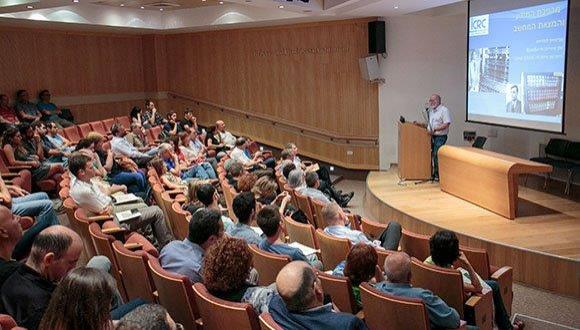סמינר-מחלקתי-ביה"ס-להנדסה-מכאנית-Lior-Avivi-and-Hila-Ben-Gur

School of Mechanical Engineering Seminar
Wednesday, November 9, 2016 at 15:00
Wolfson Building of Mechanical Engineering, Room 206
Hemodynamic Evaluation of the Abdominal Aorta post 'Chimney' Endovascular
Aneurysm Repair
Hila Ben Gur
M.Sc. Student of Dr. Gábor Kósa and Dr. Moshe Brand
An abdominal aortic aneurysm (AAA) is defined as a local dilation of the abdominal aorta with a diameter of 3 cm, or an increase of 50% from its native diameter. Ruptured aortic aneurysms are a main cause of death in the elderly population throughout the western world, with a mortality rate of 85 - 90%. In recent years, more aneurysm repairs are performed endovascularly using stent grafts (SGs) rather than open repairs. Endovascular aneurysm repairs (EVAR) are minimally invasive procedures that involve delivery of SGs to the aneurysm site through the arterial system.
AAAs located near the ostia of the renal arteries present a technical challenge for standard EVAR procedures. A standard SG delivered to such an AAA might block the ostia of the renal arteries, thus impeding their function. A widely used solution for this situation is a fenestrated SG system. In order to maintain blood flow, the main SG contains openings through which branching SGs are inserted into the renal arteries. This solution necessitates a custom made SG tailored to the aortic morphology of each specific patient. This system is costly and involves a lengthy fabrication process, and as such is not relevant in critical cases. A recent alternative to the fenestrated SG system is the 'chimney' endovascular aneurysm repair (ChEVAR). This technique involves the insertion of standard tubular SGs into the renal arteries parallel to the main aortic SG. These additional SGs are termed 'chimneys' or 'Chimney' Stent Grafts (CSGs).
In this study, computational fluid dynamics (CFD) is employed to investigate idealized models of two configurations of an aorta post ChEVAR. These configurations differ in CSG protrusion length. The CSGs have free ends that protrude above the main aortic SG by 30 mm in the longer configuration and by 10 mm in the currently accepted surgical configuration. The models are evaluated and compared to a healthy aorta model.
Results demonstrate that the presence of CSGs appears to cause negative variations in the velocity and wall shear stress (WSS) fields. These include confined regions of stagnation and recirculation also characterized by somewhat lower WSS. Nevertheless, in general, the flow field seems to remain nearly unaffected in adjacent segments upstream and downstream from the site of the CSGs. Furthermore, the flow field in the aortic duct seems to remain laminar, further indicating the confined influence of the ChEVAR procedure. The effects of the CSGs seem slightly more distinct for the longer CSG configuration than for the shorter one. However, we conclude that the longer configuration cannot be ruled out as a potentially valid surgical option since the differences between the two configurations are mild.
To the best of our knowledge, this study represents the first evaluation of hemodynamic effects of the ChEVAR procedure on the abdominal aorta following an infrarenal AAA.
School of Mechanical Engineering Seminar
Wednesday, November 9, 2016 at 15:00
Wolfson Building of Mechanical Engineering, Room 206
Measurement of Volumetric Convection Coefficient
in Porous Media
Lior Avivi
MSc Student of Prof. Avi Kribus
The combination of high surface area and low pressure drop makes the use of porous media (PM) as heat or mass exchangers a considerable interest in many applications such as combustors, incinerators, catalyst support media in chemical reactors, regenerative heat exchangers, and volumetric solar receivers. Increasing the convection capabilities will result with a direct impact on the efficiency and economics of these applications. Due to the tortuous and complex nature of flow in PM, measurement of convective heat transfer poses many difficulties, and previous methods were relying on complex transient procedures and conduction-based sidewall heating.
A new method is presented for measurement of the volumetric convection coefficient in porous media, using a steady state experiment in a low-speed wind tunnel and volumetric electrical heating of the test sample. This approach is enabled by 3-D printing of the tested geometry allowing high flexibility in the tested geometry, and the availability of an electrically conductive polymer that allows distributed heating of the sample. The experimental method is described and demonstrated with a study of convection in periodic porous meshes, intended for optimization of structures for solar volumetric absorbers. One PM design candidate for high-performance solar volumetric absorbers will be presented and analyzed, and the measured volumetric convection coefficients will be compared to existing correlations in the literature. Still, when developing new experimental methods, some challenges are yet to overcome, and will also be discussed.


